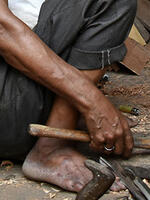Filter by...
Reset all
Publications (434)

Wage inequality in India has declined over the past two decades. This article examines the role of rising minimum wages in driving this trend. Exploiting state-level variations in legislative minimum wage changes, it finds that minimum wage increases account for 26% of the decline in wage inequality...
Working Paper
pdf
– Theory and experimental insights from local politicians in India
Economic theory predicts that dishonesty thrives in secrecy. Yet, team-based decisions are ubiquitous in public policy-making. How does teamwork influence the tendency for self-dealings when public servants—both honest and corrupt—must work together to make decisions under the veil of within-group...

Growing income inequality poses a major global challenge, even as the inequality between countries has shrunk due to rapid economic growth in nations like China and India. Both Indonesia and India experienced decades of gradually increasing national income inequality, beginning in the 1980s. The...
Working Paper
pdf
Drawing from two labour market experiments in rural India, we offer insights on the influence of survey design on the measurement of employment. The first experiment contrasts self-reported estimates of employment with proxy-reported estimates from spouses. We find that employment estimates based on...

‘The Number of Countries with High Inequality’ is the World Bank’s newest inequality indicator, one which it says will guide work on its agenda to ‘end poverty on a livable planet’. The indicator uses a country’s most recent Gini score, classifying it as a high inequality country if Gini is 40 or...
Journal Article
The shale gas revolution in the United States induced an unprecedented commodity boom across northwestern India. Leveraging population-based discontinuities in the contemporaneous roll-out of India’s national rural electrification scheme, we show that access to electricity increased total employment...
Journal Article
This paper examines labour market inequality in Indonesia and India, using a common conceptual approach that draws on a job ladder framework. In the framework, I differentiate between self-employment and wage-informal employment and between formal, upper-tier informal and lower-tier informal...
Journal Article
This peer-reviewed research is available free of charge. UNU-WIDER believes that research is a global public good and supports Open Access.
We examine how politicians and non-politicians in rural India respond to behavioural incentives. Using a modified dictator game, we vary treatments (and incentives) across the nature of interactions, the visibility of actions, and an upfront promise. Under anonymity, politicians and non-politicians...
Book Chapter
This peer-reviewed research is available free of charge. UNU-WIDER believes that research is a global public good and supports Open Access.
– A Case of Domestic Workers in Delhi
From the book:
COVID-19 and the Informal Economy
Journal Article
– Evidence from India
This study analyses whether living in a locality with high crime against women affects the probability of early marriage — that is, marriage before the legal age of marriage of girls. Using a nationally-representative longitudinal dataset and tackling the potential endogeneity of local crime rates...
Working Paper
pdf
– Indonesia and India compared
We examine the nature of labour market inequality in Indonesia and India, using a common conceptual approach drawing from the job ladder framework. In the framework, we differentiate between self-employment and wage-informal and between formal, upper tier informal, and lower tier informal jobs. We...
Blog
More than 960 million Indians will head to the polls in the world’s biggest election between April 19 and early June. The ruling Bharatiya Janata Party (BJP), which is led by Prime Minister Narendra Modi, is seeking a third term in office. And the polls suggest it will achieve this objective.If one...
Journal Article
This peer-reviewed research is available free of charge. UNU-WIDER believes that research is a global public good and supports Open Access.
– Theory and some evidence from India
Using the lens of a life-cycle model, we argue that an administrative failure of a wage payment delay in a workfare programme could adversely affect the welfare of the poor through two channels. First, it imposes an implicit consumption tax on the household. Second, it changes the status of labour...
Journal Article
– Exploring the distribution of women's work between income generation, expenditure-saving, and unpaid domestic responsibilities in India
Part of Journal Special Issue
Women’s Work
Working Paper
pdf
The documented under-representation of marginalized groups in business ownership and the labour market is a concerning issue. This study explores how caste disparities in small-firm entrepreneurship impact on firm performance in India, focusing on the informal sector. Our examination shows a...
Working Paper
pdf
Time-use statistics are sensitive to measurement error, especially errors that might be introduced based on whether the informant is reporting on herself or reporting on others in the household. In this paper, we use the nationally representative time-use survey in India and propensity score...
Displaying 16 of 434 results
 Join the network
Join the network